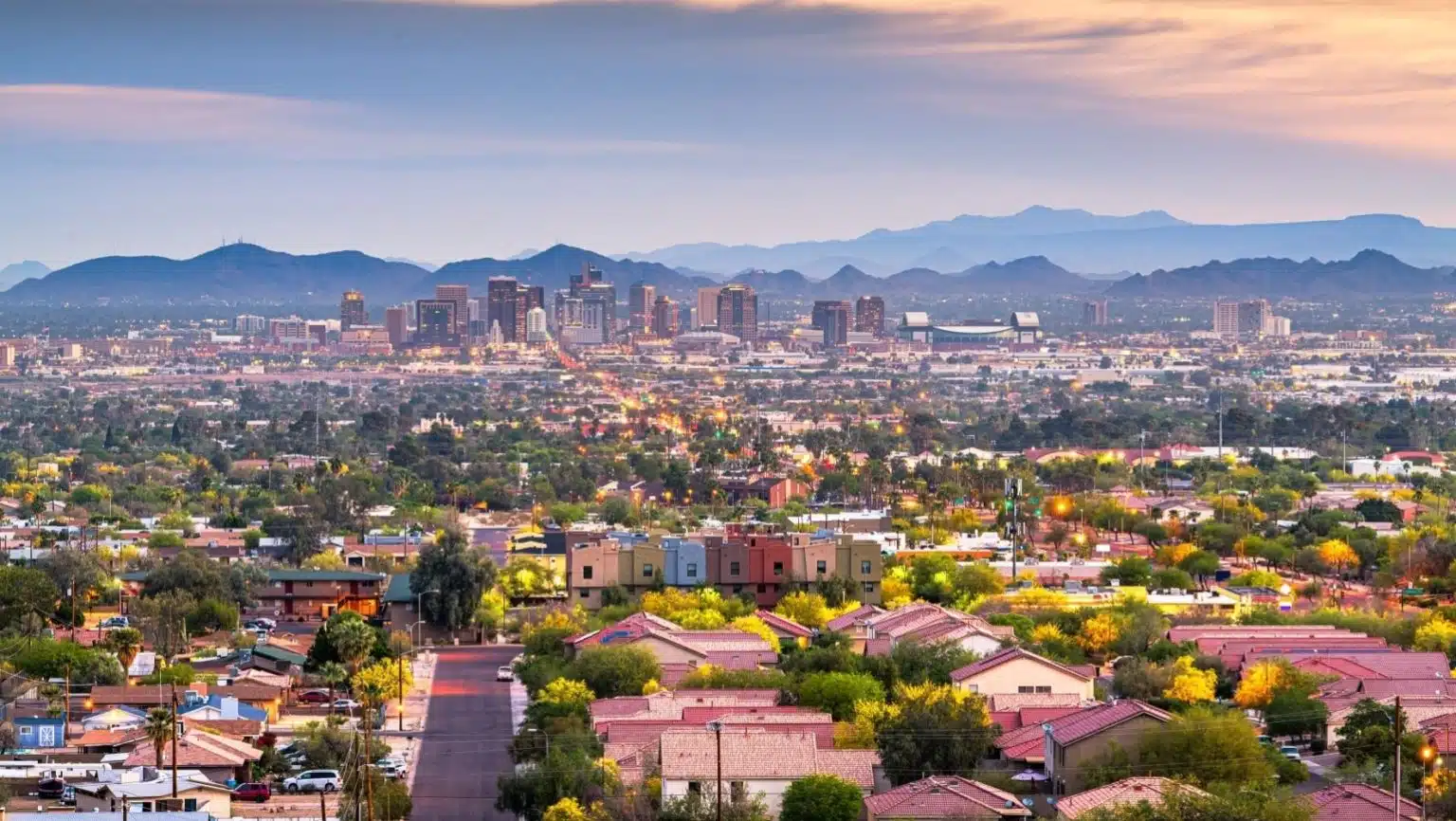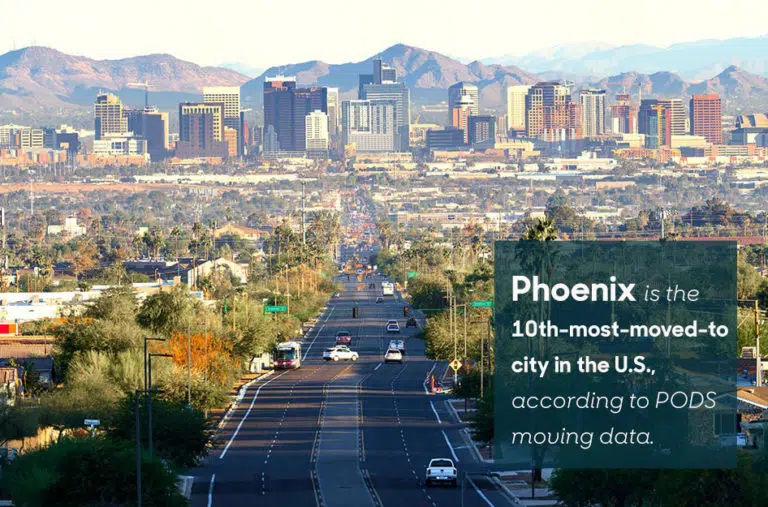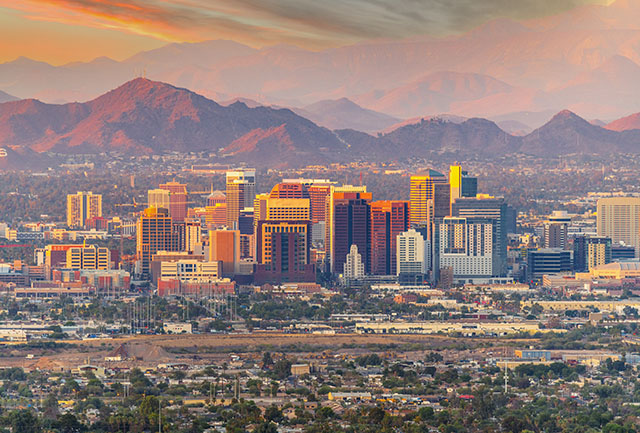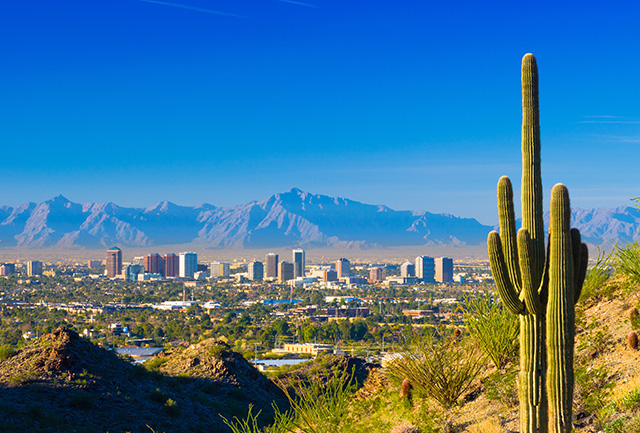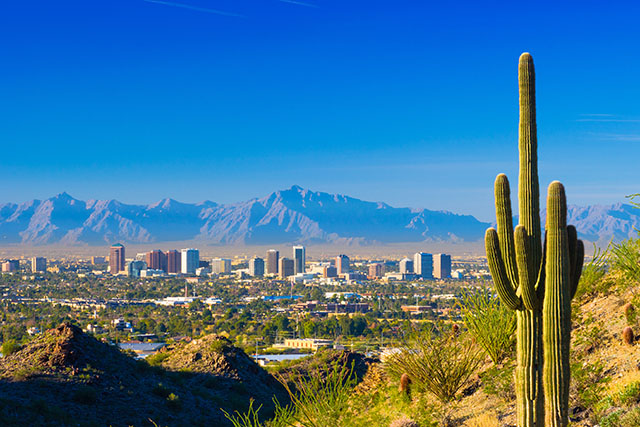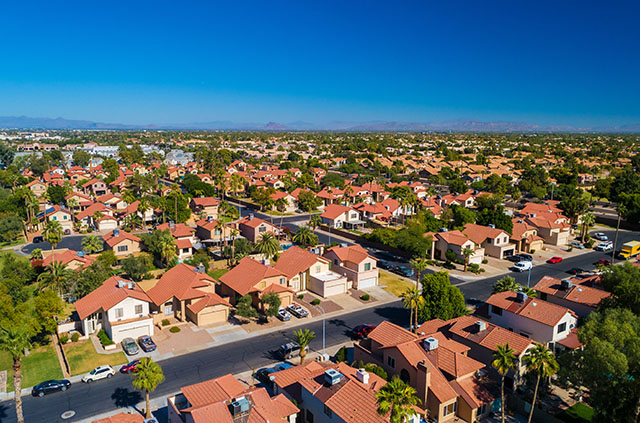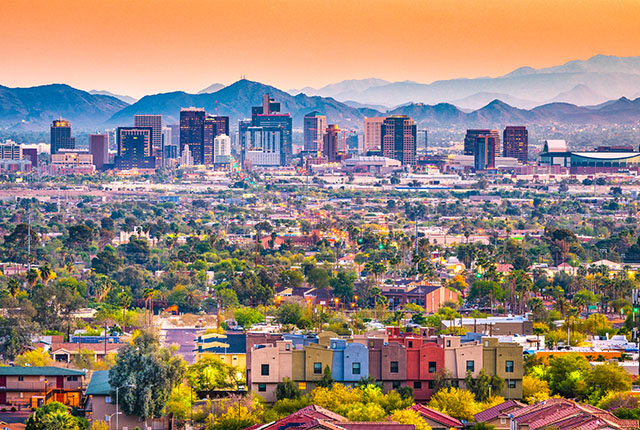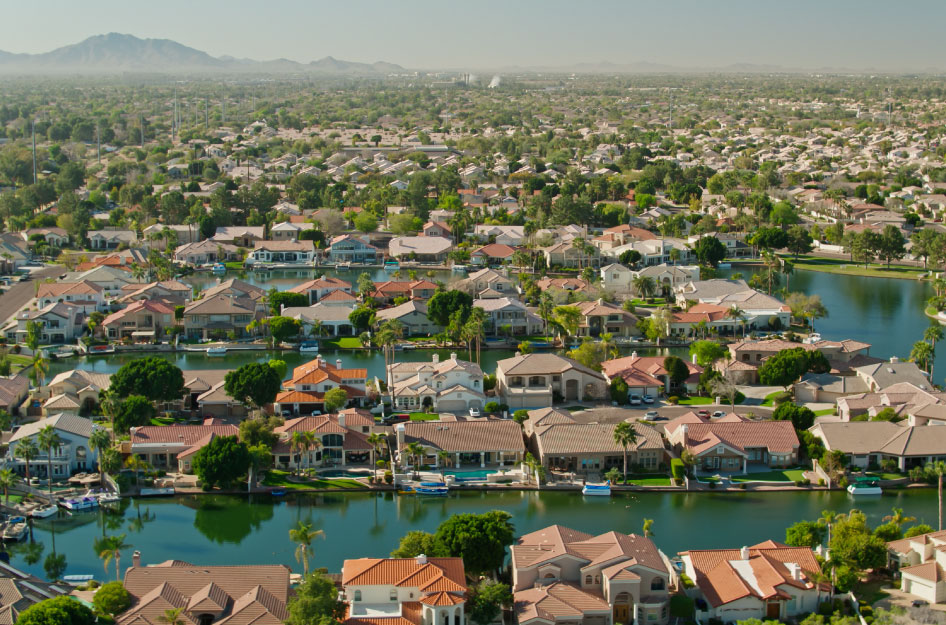What’s Living in Phoenix Like? 18 Things To Know Before Moving Here
PhoenixArizona
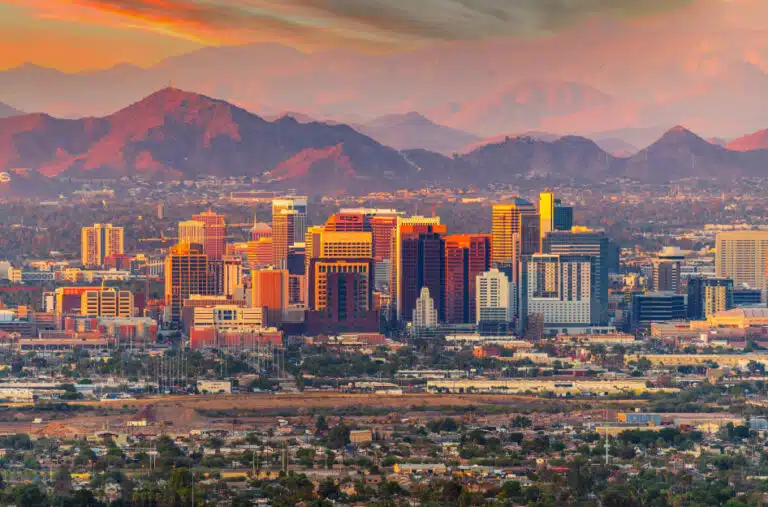
Should I move to Phoenix? Well, if you want to escape the high prices of California but still enjoy year-round sun, practically non-existent rain, and bountiful outdoor activities (Hard sell, right?), living in Phoenix may be the perfect decision for you.
Based on the most recent data from Macrotrends, Phoenix’s metro area population currently sits just over 4.8 million, which is an increase from 2024. In fact, Metro Phoenix's population grew by nearly 85,000 people between 2023 and 2024, which is largely attributed to international migration, according to U.S. Census Bureau estimates.
Why are so many people moving to Phoenix? While this sprawling city may be stereotyped as a retirement paradise, it’s actually so much more. Thanks to its warm weather, great job opportunities, growing population, and strong local economy, it’s a popular spot for everyone — from young professionals to families to, yes, retirees.
Where are these newcomers living in Phoenix moving from? According to Common Sense Institute Arizona, most are coming from California, Florida, Oregon, Texas, and Washington.
If, like so many others, you’re planning on moving to Phoenix — or simply want to learn more about what makes this sunny locale so special — we think there are some things you should know about living in Phoenix.
| Planning on moving to Phoenix? Start by getting a quote from PODS. |
Before we dive into the details, though, take a virtual tour of Downtown Phoenix to get a sneak peek of what the city has to offer.
Living in Phoenix: At a Glance
- Phoenix is located in the south-central portion of the state, about 120 miles north of the Mexican border. It’s located between El Paso, Texas, and Los Angeles, California.
- It’s the only state capital with a population of more than one million residents, with over 1.65 million people.
- It’s the most populous state capital in the nation, the fifth most populous city in the U.S., and the most populous city in the state of Arizona.
- The median age is 34.9 (lower than the national median of 38.5), and the median household income is $79,664.
It’s always sunny in Phoenix … well, almost. The city sees around 300 sunshine-filled days per year.
(Source: TheHappyCamper)
1. The City Has a Hot Nickname
And we’re being literal here. Phoenix is known as the “Valley of the Sun” because it sees more sunny days (around 300) than any other metropolitan city in the nation. If you’re moving to Phoenix, don’t forget to pack the sunscreen.
It rarely rains — accumulating an average of just eight inches per year — and, when it does rain, it happens only during a few large summer storms, called “monsoons.” Phoenix is also sometimes referred to as the “Salt River Valley,” or, to locals, typically just “the Valley.”
2. Living in Phoenix Means Loving the Heat
If you can’t stand the heat, get out of the desert. Phoenix weather is what draws many people to the area, but it can also be tough to get used to, especially during the summer months. It’s not unusual for summer days to be more than 100°F. In fact, between May and September, there’s an average of more than 100°F days, with temps in the 100–105°F range. The hottest temperature ever recorded was 122°F on June 26, 1990. Grab your wide-brimmed hat and ditch the leather car seats. These summers are no joke.
What are the best months to live in Phoenix? Most people will tell you that the best months for living in Phoenix happen during the spring and winter seasons, thanks to average highs in the 70s.
Similarly, if you’re looking for a white Christmas, this might not be the place for you. Snow is rare in Phoenix and accumulations of 0.1 inches or greater have been recorded fewer than ten times.
You’ll have to get used to dust storms if you’re living in Phoenix.
3. Haboobs Are Real — and Another Part of Life in Phoenix.
No, we’re not being silly or inappropriate. During the driest months of the year — usually between July and August — there can be dust storms called “haboobs.”
Getting their name from the Arabic word for “blown,” haboobs are giant walls of dust created from the high winds of a collapsing thunderstorm. They feature gusts of sand and dust and last around three hours. They can be large and dangerous, so be prepared if one’s in the forecast.
4. There’s a “Greater” Phoenix
Geographically speaking, there’s the city of Phoenix and Downtown Phoenix, then there are surrounding valleys. This is what makes up Greater Phoenix — the entire area measuring about the size of Delaware and comprising more than 20 cities and towns, including Scottsdale, Tempe, Mesa, and Glendale.
5. The Cost of Living in Phoenix, Arizona, Is Only Slightly Higher Than the National Average
Compared to coastal metropolitan cities like San Francisco, San Diego, and New York City, the cost of living in Phoenix, Arizona, is much more affordable. According to RentCafe, the cost of living in Phoenix is three percent lower than the state average, but it is three percent higher than the national average (consider that San Francisco’s cost of living, though, is 71 percent higher than the national average).
For those who live on a fixed income, like retirees, Phoenix is an ideal location because not only does it have a low cost of living, but property taxes are also lower than other large retirement destinations like Boca Raton or Orlando. There’s also a notable tax savings for all Phoenix residents because of the city’s hefty tourism income.
So, in summary, here’s an overview of the cost of living in Phoenix, Arizona:
- It’s more affordable than coastal cities: Phoenix’s cost of living is much more affordable than San Francisco or San Diego
- The cost of living in Phoenix is lower than the state average: Living in Phoenix comes with a cost of living that’s 3% lower than the state average and 3% higher than the national average.
- Phoenix is retiree-friendly: Phoenix has lower property taxes than Florida or California and no tax on Social Security benefits.
- There are tourism-driven tax benefits: High revenue from tourists keeps local taxes relatively low.
- Housing costs aren’t low, but they are competitive: Median home prices hover around $416,700, which is lower than the Arizona state average and average home prices in places like Austin, Texas, and Miami, Florida.
| Q: What salary do you need to live comfortably in Phoenix? A: According to MIT’s Living Wage Calculator, a family of four with two working adults requires a combined annual salary of around $123,200 (before taxes) to cover typical expenses in Phoenix. To live comfortably and have enough to afford hobbies and entertainment, pay off debts, and/or save for the future, they would need to earn double that. A single person without children would need to earn about $107,000 annually before taxes to live comfortably in Phoenix. |
Moving to Phoenix? There are various home types in the area to appease (almost) every buyer’s needs.
(Source: Jera Banks Realtor - Home Sweet Phoenix via Facebook)
6. There Are a Variety of Housing Options for Those Moving to Phoenix
Phoenix’s population growth has increased the demand for housing on both the purchase and rental sides. Zillow reports that the average home value has almost reached the $417,000 mark, but it’s still cheaper than a starter home in coastal California.
To add to the convenience, there’s a variety of home styles in the area. While most are single-family residences, there are also condos and townhomes. The large retiree market means there is strong demand for one- and two-bedroom houses and condos, and those units are a fraction of the cost of a three-bedroom home.
If included amenities are your thing, check out the master-planned communities, which appear in much of the Southwest. These large-scale neighborhoods come with recreational and commercial features like golf courses, parks, swimming pools, playgrounds, and even restaurants and shopping centers.
7. Renters Can Find Something In Their Price Range, Too
According to data from RentCafe, these are the most affordable neighborhoods for rentals, with average monthly rents throughout the city right around $1,500 per month.
- Alhambra ($1,250 per month)
- North Mountain Village ($1,250 per month)
- Maryvale ($1,400 per month)
- Central City ($1,425 per month)
Other areas with lower-than-average rent prices include Deer Valley Village, Encanto Village, and Camelback East.
On the higher end of the scale are the Valley Vista, Desert View, and Downtown Phoenix neighborhoods. There, average rent ranges from $1,990 to over $2,150 per month.
| Q: Is it better to live in Phoenix or Las Vegas? A: Is Phoenix a good place to live or is Las Vegas preferable? That depends on what you want out of a city. The cost of living in Phoenix is higher, but only by three percent. Overall, the vibe in Phoenix is more balanced, there are better job opportunities, and a stronger sense of community — especially if you’re moving to Phoenix with a family. Las Vegas has more nightlife and entertainment options, thus giving it more excitement. |
Downtown Scottsdale is known for its vibrant arts scene and cultural attractions. Not to mention the gorgeous mountain views.
8. The Best Places To Live Include Downtown Scottsdale, Paradise Valley, and Arcadia
What is the nicest area of Phoenix to live in? That answer depends on your preferences. Maybe you want to be in the heart of the city. Or perhaps you’re craving a more suburban lifestyle. Our Phoenix Neighborhood Guide breaks down several options, but here are three standouts:
Downtown Scottsdale
Filled with luxury apartments, mixed-use buildings, corporate offices, and a thriving arts scene, this is a popular place for young professionals. Average home prices are around $848,200, according to Zillow, and average rent is around $2,050 per month, according to RentCafe.
Paradise Valley
Nicknamed the “Beverly Hills of Phoenix,” this once-rural area now has million-dollar homes, golf courses, resorts, and spas. Sounds like paradise to us — and it should feel that way, too, with average home prices just above $3.3 million! There are some rental options, though, averaging slightly around $1,850 a month.
Arcadia
For those who like to balance work and play, Arcadia has not only picturesque, family-friendly neighborhoods but also vibrant dining and shopping options. While less than the average home price of Paradise Valley, Arcadia still has a steep average home price, which hovers around $969,100. Rent is a little more on par with the state average, though, coming in around $1,975 per month.
Other top places to live include:
- Chandler
- Gilbert
- Litchfield Park
- Queen Creek
- Peoria
| Insider Tip: When you’re ready to start planning your move, visit PODS.com to get a personalized local moving quote or call 877-350-7637 for long-distance moving. |
Phoenix is home to a diverse range of schools, including public, charter, and private institutions.
(Source: Scottsdale Unified School District via Facebook)
9. When It Comes to Selecting a School, You’ll Need To Do Your Research.
As you can imagine, in a city as large as Phoenix, there are several options for where your kids can go to school. Maricopa County has almost 1,000 schools in its districts, so consult a realtor or do some independent research to find the best option for your situation.
According to Niche, these are the top five districts in Maricopa County:
- Chandler Unified School District No. 80
- Heritage Academy
- Scottsdale Unified School District
- Paradise Valley Unified School District
- Gilbert Public Schools
If you’re interested in a private education, high-rated schools include Phoenix Country Day School, Brophy College Preparatory High School, Arizona Cultural Academy & College Prep, Rancho Solano Preparatory School, and Gary K. Herberger Young Scholars Academy.
And for higher education, Phoenix is home to Arizona State University, The University of Arizona College of Medicine, and Grand Canyon University.
10. Say Goodbye To Springing Forward
Can’t stand setting your clocks ahead one hour for Daylight Saving Time? So do Arizonians. In fact, they disliked it so much that they did away with Daylight Saving Time entirely in 1968.
Why did they make this decision? According to this article, it likely has to do with the weather. Making the change to Daylight Saving Time means more sunlight — and more heat. Many Arizonians are against the switch to Daylight Saving Time because that means the sun would be out until around 9 p.m., making nighttime activities almost impossible.
Arizona is in Mountain Standard Time, and they stay in that zone all year long. So during Daylight Saving Time (March through November), Arizona has the same time as the Pacific Time Zone. Trust us, it’s less confusing than it sounds.
The Sonoran Desert is known for its natural beauty and striking green landscapes.
(Source: Drew Hays via Unsplash)
11. Forget What You Think You Know About Deserts
Phoenix is located in the Sonoran Desert, a piece of land that covers approximately 100,000 square miles and includes most of the southern half of Arizona, Southeastern California, most of the Baja California peninsula, the Gulf of California, and a significant portion of Sonora, Mexico.
While you may think of a desert as a dry, beige, flat area of land with cacti and tumbleweeds, the Sonoran Desert offers a bit more, at least in the springtime. It gets more rainfall than other deserts, creating a beautiful green landscape and abundant patches of wildflowers. Of course, if you want to see a cactus, you’re in the right place. The Sonoran has plenty of those, too. It is still a desert, after all.
12. You’ll Need a Car To Get Around, But Driving Is a Breeze
While walking in Phoenix is a nice activity, it can’t be your sole method of transportation if you’re living in Phoenix full time. But thanks to a well-planned grid road system and High-Occupancy Vehicle (HOV) lanes that alleviate congestion, driving isn’t a total headache. If you’re looking for a more environmentally friendly option, try the affordable light rail transportation system or metro bus service.
If you want some exercise as you travel and you live in or near Downtown Phoenix, the Bicycle Boulevard is a 4.6-mile stretch of bike lane that cyclists use to safely commute throughout the area.
For longer commutes (say, to another state), two commercial airports are in the Phoenix area: Phoenix Sky Harbor Airport and Phoenix-Mesa Gateway Airport.
"
LLike to hit the links? You’ll love living in Phoenix.
(Source: Visit Phoenix via Facebook)
13. There’s Something “Fore” All Outdoor Lovers
Is Phoenix a good place to live? It is if you’re a golf fanatic!
Phoenix is a golfer’s dream. With more than 200 courses and home to the Waste Management Phoenix Open, the largest annual PGA event, there’s no shortage of ways to hit the links or watch the pros in action.
And for those who like to be closer to nature, Phoenix has more than 180 city parks and more than 33,000 acres of desert preserves. There are several hiking trails in the Phoenix Mountains Preserve, or you can kayak on Tempe Town Lake. To see wildlife in its natural habitat, check out the Desert Botanical Garden.
| Q: Is it worth it to move to Arizona? A: Many people consider living in Phoenix (and Arizona as a whole) absolutely “worth it” because it’s a stunningly beautiful place filled with tons of outdoor activity spaces. There’s also a somewhat affordable cost of living in Phoenix, if you’re comparing it to other major metropolitan areas. Plus, if you loathe cold temps, you’ll love that it rarely gets below 60 degrees. However, it’s blazing hot in the summer, averaging over 100 degrees in June, July, and August. Also, when compared to other metro cities like New York or Chicago, Phoenix is much less walkable and doesn’t have strong public transportation. |
14. Sports Fans Have Their Bases Covered.
No matter your favorite sport, Phoenix has you covered. It’s home to the following franchises:
- Arizona Coyotes (NHL)
- Arizona Diamondbacks (MLB)
- Phoenix Suns (NBA)
- Arizona Cardinals (NFL)
- Phoenix Mercury (WNBA)
| Fun Fact: Only 13 other U.S. cities have the same professional sport representation. |
Adventuring is a popular pastime in Phoenix.
(Source: Desert Wolf Tours via Facebook)
15. There’s Plenty of Room for Work and Adventure
All work and no play has no place for those living in Phoenix. Sure, there are vast employment opportunities, thanks to a growing tech scene and tourism industry, but there’s something to be said about balancing your professional pursuits with some thrill-seeking adventures. Here are some top spots to enjoy a nice rush of adrenaline:
Move over, boring museums. Kids love the hands-on exhibits at the Children’s Museum of Phoenix.
(Source: Children’s Museum of Phoenix via Facebook)
16. The Whole Family Can Find Something Fun To Do
Looking for some family-friendly activities? Phoenix has you covered. Phoenix offers a wide variety of options, from hands-on learning to interactive exhibits and encounters with wildlife. Visit one of these popular spots, and you may find that the kids aren’t the only ones having the time of their lives.
Phoenix’s rich culture touches everything in the city, from the entertainment scene to the culinary experiences.
(Source: Heard Museum via Facebook)
17. The Arts Scene Is Second to None
Phoenix is a vibrant hub for arts, culture, and entertainment, offering an array of attractions that showcase its rich heritage and contemporary creativity. From the renowned Heard Museum, which celebrates Native American culture, to the Phoenix Art Museum with its diverse collections of modern and classical works, there’s something for every art lover. If live entertainment is more your thing, check out a performance at the Phoenix Symphony or snag some tickets to a show at the Arizona Theatre Company. That’s not all, though:
Need a nosh? You’ll never run out of trendy new spots to try in Phoenix.
(Source: Rusconi’s American Kitchen via Facebook)
18. From Fine Dining to Food Trucks, Phoenix Is Filled With Good Eats and Tasty Treats
Phoenix’s food scene is a flavorful mix of Southwestern flair, diverse global cuisines, and farm-to-table freshness. Known for its vibrant Mexican and Native American influences, the city offers everything from authentic street tacos to creative modern twists on traditional dishes. Local favorites include Sonoran-style cuisine, featuring ingredients like mesquite-grilled meats and fresh salsas.
| Q: What is the vibe in Phoenix? A: The vibe in Phoenix is laid-back, sun-soaked, outdoorsy, and a bit resort-y. |
Ready To Start Living in Phoenix? PODS Can Help
We could go on and on about what makes this city shine, but we think it’s time to check it out for yourself. Whether you’re moving to Phoenix from somewhere local or across the country, PODS can help. Have a portable moving container delivered to your driveway for convenient packing and loading. One month of storage is included in the cost of every PODS move, so you don’t have to feel rushed. When you’re ready, schedule your container to be picked up and delivered to your new home in sunny Phoenix.
| Need help planning your move? Start with this handy moving checklist or compare long-distance moving costs right here on the PODS Blog. |
Editor’s note: For ease of reading, monthly rental prices were rounded to the nearest $25, and home values were rounded to the nearest $100. Home values in the millions were rounded to the nearest $100,000.

Your quote in 60 seconds
Get pricing tailored to your needs!
